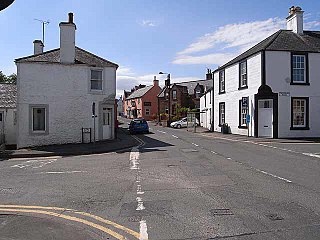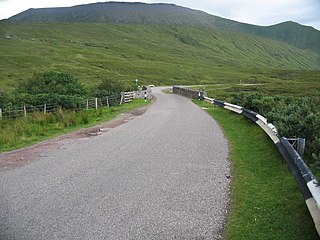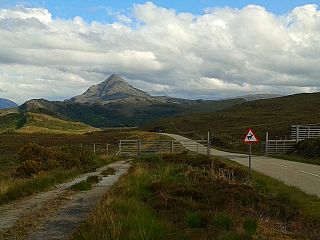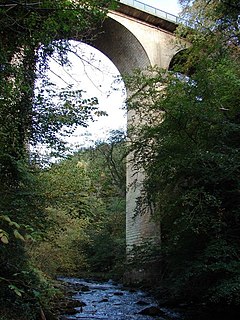Laxford Bridge | |
|---|---|
 | |
| Coordinates | 58°22′29″N05°01′01″W / 58.37472°N 5.01694°W Coordinates: 58°22′29″N05°01′01″W / 58.37472°N 5.01694°W |
| Carries | A838 road |
| Crosses | River Laxford |
| Heritage status | Category B listed |
| Characteristics | |
| Material | Stone rubble |
| History | |
| Construction end | c.1834 |
The Laxford Bridge is a stone arch bridge in Sutherland, Scotland which carries the A838 across the River Laxford north to Rhiconich and Durness.

Sutherland is a historic county, registration county and lieutenancy area in the Highlands of Scotland. Its county town is Dornoch. Sutherland borders Caithness and Moray Firth to the east, Ross-shire and Cromartyshire to the south and the Atlantic to the north and west. Like its southern neighbour Ross-shire, Sutherland has some of the most dramatic scenery in the whole of Europe, especially on its western fringe where the mountains meet the sea. These include high sea cliffs, and very old mountains composed of Precambrian and Cambrian rocks.
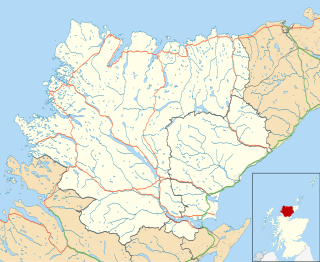
Rhiconich is a remote hamlet, located at the head of Loch Inchard, in Sutherland, Scottish Highlands in the Scottish council area of Highland. Rhiconich is situated 3 miles (4.8 km) north-east of Laxford Bridge and 11 miles (18 km) south-west of Durness on the A838 road. The B801 at Richonich links the village of Kinlochbervie and associated crofting townships such as Oldshoremore to the A838.

Durness is a village and civil parish in the north-west Highlands of Scotland. It lies on the north coast of the country in the traditional county of Sutherland, around 120 miles (190 km) north of Inverness. The area is remote, and the parish is huge and sparsely populated, covering an area from east of Loch Eriboll to Cape Wrath, the most north-westerly point of the Scottish mainland.
The bridge was built about 1834 by the Dukes of Sutherland – the road from Lairg, one of the "destitution roads" built during the potato famine, not being completed until 1851. [1] [2] [3] The bridge is a category B listed building. [4]

The Highland Potato Famine was a period of 19th century Highland and Scottish history over which the agricultural communities of the Hebrides and the western Scottish Highlands saw their potato crop repeatedly devastated by potato blight. It was part of the wider food crisis facing Northern Europe caused by potato blight during the mid-1840s, whose most famous manifestation is the Great Irish Famine, but compared to its Irish counterpart it was much less extensive and took many fewer lives. The terms on which charitable relief was given, however, led to destitution and malnutrition amongst its recipients. A government enquiry could suggest no short-term solution other than reduction of the population of the area at risk by emigration to Canada or Australia. Highland landlords organised and paid for the emigration of more than 16,000 of their tenants and a significant but unknown number paid for their own passage. Evidence suggests that the majority of Highlanders who permanently left the famine-struck regions emigrated, rather than moving to other parts of Scotland. It is estimated that about a third of the population of the western Scottish Highlands emigrated between 1841 and 1861.
An army transporter crashed on the bridge in 2009 causing so much damage that it had to be closed to traffic. Detours of at least 97 kilometres (60 miles) were required (off-road) and the additional distance by road was 160 kilometres (100 miles). [5]






